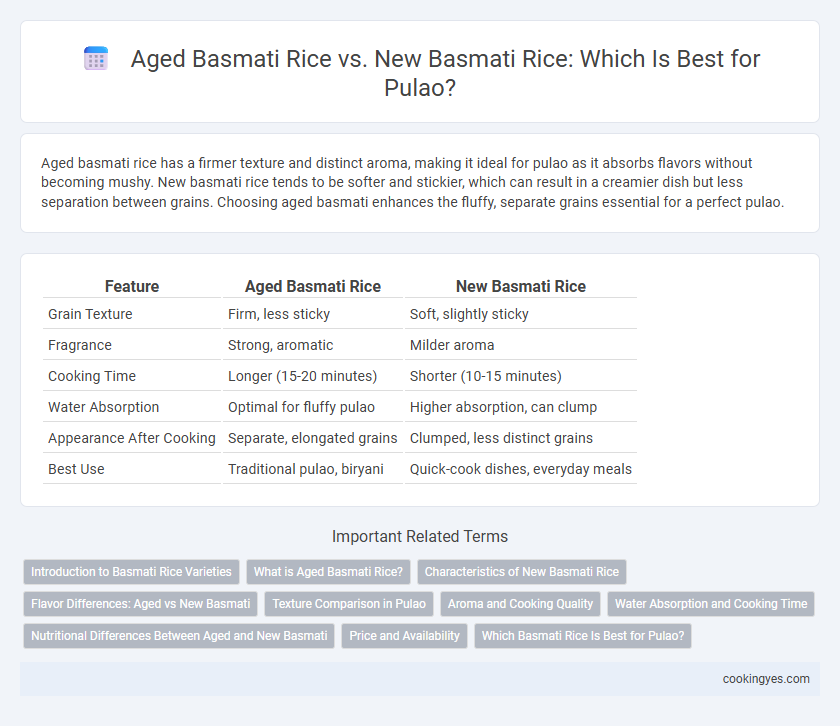Aged basmati rice has a firmer texture and distinct aroma, making it ideal for pulao as it absorbs flavors without becoming mushy. New basmati rice tends to be softer and stickier, which can result in a creamier dish but less separation between grains. Choosing aged basmati enhances the fluffy, separate grains essential for a perfect pulao.
Table of Comparison
| Feature | Aged Basmati Rice | New Basmati Rice |
|---|---|---|
| Grain Texture | Firm, less sticky | Soft, slightly sticky |
| Fragrance | Strong, aromatic | Milder aroma |
| Cooking Time | Longer (15-20 minutes) | Shorter (10-15 minutes) |
| Water Absorption | Optimal for fluffy pulao | Higher absorption, can clump |
| Appearance After Cooking | Separate, elongated grains | Clumped, less distinct grains |
| Best Use | Traditional pulao, biryani | Quick-cook dishes, everyday meals |
Introduction to Basmati Rice Varieties
Basmati rice varieties include aged and new basmati rice, each impacting pulao preparation differently due to moisture content and aroma. Aged basmati rice, typically stored for 12-24 months, has reduced moisture, leading to longer, fluffier grains and a distinct nutty fragrance ideal for pulao. New basmati rice contains higher moisture, cooks faster, and produces a stickier texture, which may affect the final dish's fluffiness and separation of grains.
What is Aged Basmati Rice?
Aged basmati rice refers to grains that have been stored for at least 12 months after harvesting, allowing the moisture content to reduce and the starch to crystallize, resulting in longer, fluffier, and non-sticky cooked rice. This aging process enhances the aroma and flavor, making aged basmati rice ideal for dishes like pulao where separate, distinct grains are desired. New basmati rice, being fresher with higher moisture, tends to be softer and can clump together, which may affect the texture of pulao.
Characteristics of New Basmati Rice
New basmati rice grains are fresher, softer, and have higher moisture content compared to aged basmati rice, resulting in a stickier texture when cooked. It retains a more delicate aroma and tends to cook faster but requires careful water management to avoid clumping. These characteristics make new basmati rice ideal for dishes like pulao that benefit from a moist, tender grain.
Flavor Differences: Aged vs New Basmati
Aged basmati rice offers a nutty, rich aroma and firmer texture ideal for pulao, enhancing each grain's distinctness during cooking. New basmati rice tends to be softer and slightly sticky with a milder fragrance, resulting in a more delicate pulao texture. The aging process intensifies flavor complexity, making aged basmati preferred for aromatic, flavorful pulao dishes.
Texture Comparison in Pulao
Aged basmati rice offers a firmer, less sticky texture ideal for pulao, ensuring each grain stays separate and fluffy. In contrast, new basmati rice tends to have higher moisture content, resulting in a softer, more adhesive texture that can cause clumping in pulao. The choice between aged and new basmati rice directly affects the pulao's mouthfeel and visual appeal, with aged varieties preferred for a distinct grain structure.
Aroma and Cooking Quality
Aged basmati rice offers a distinct aromatic profile with enhanced nutty and floral notes, ideal for flavorful pulao preparations. Its grains remain separate and firm after cooking, preventing clumping and ensuring a light, fluffy texture. In contrast, new basmati rice has a fresher, milder aroma and a slightly softer texture, which may result in stickier pulao due to higher moisture content.
Water Absorption and Cooking Time
Aged basmati rice typically absorbs water more efficiently than new basmati rice, resulting in fluffier and less sticky pulao grains. The cooking time for aged basmati rice is generally longer, around 20-25 minutes, allowing the grains to expand fully without breaking. New basmati rice cooks faster, usually within 15-20 minutes, but may require careful water adjustments to avoid mushy textures in pulao.
Nutritional Differences Between Aged and New Basmati
Aged basmati rice contains lower moisture content and higher starch crystallinity, resulting in a firmer texture and enhanced aroma ideal for pulao preparation. New basmati rice retains more moisture and vitamins like thiamin and niacin but tends to produce a softer, stickier pulao. Nutritionally, aged basmati rice offers a slightly higher glycemic index, while new basmati rice provides more antioxidants and essential nutrients beneficial for balanced diets.
Price and Availability
Aged basmati rice commands a higher price due to its lower moisture content and enhanced aroma, making it preferred for flavorful pulao. New basmati rice is more readily available and affordable but tends to have higher moisture, resulting in a stickier texture when cooked. Consumers often choose aged basmati for premium dishes, while new basmati suits everyday cooking and budget constraints.
Which Basmati Rice Is Best for Pulao?
Aged basmati rice is preferred for pulao due to its drier texture, longer grains, and enhanced aroma, which prevent clumping and produce fluffy, separate grains. New basmati rice tends to have higher moisture content, resulting in softer, stickier grains that may not achieve the ideal pulao consistency. Therefore, aged basmati rice, typically matured for 12-18 months, is best for authentic, flavorful pulao preparation.
Aged basmati rice vs New basmati rice for pulao Infographic

 cookingyes.com
cookingyes.com